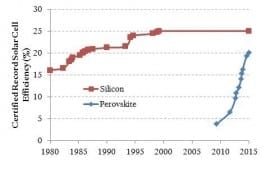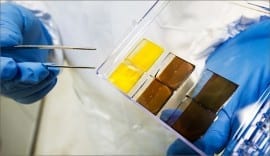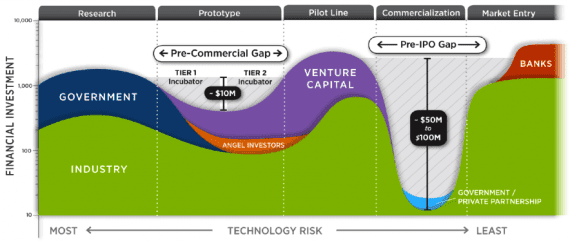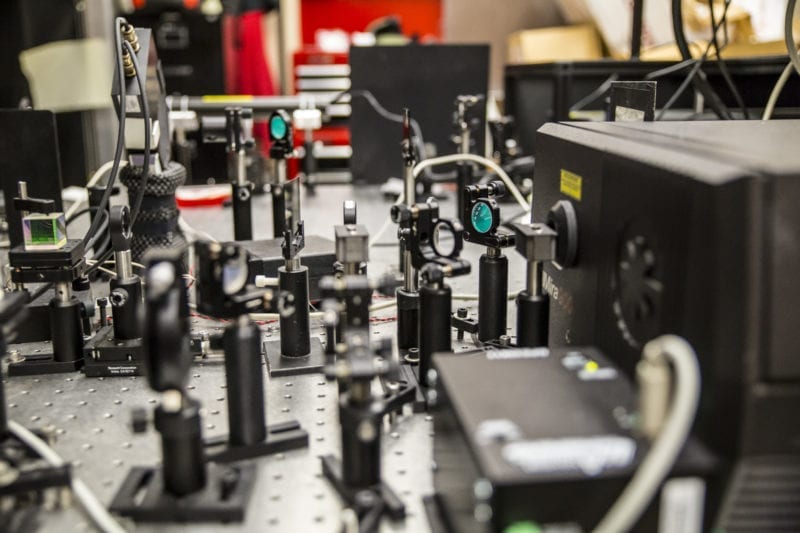
Varun Sivaram, Samuel Stranks, and Henry Snaith have written an article for Scientific American about the wonders of perovskite solar cells, which are capable of stunning achievements in the laboratory. Sivaram says, ” [M]any of us believe this is the field’s biggest breakthrough since the original invention of the solar cell sixty years ago.” Why is that?
 According to Vox, “In the future, solar power won’t just come from bulky blue panels on rooftops. The solar panels of tomorrow will be transparent, lightweight, flexible, and ultra-efficient. We’ll be able to coat shingles or skylights or windows with them — and it’ll all be as cheap as putting up wallpaper.” One principal advantage they have over conventional solar technology is that they can be engineered to react to many different wavelengths of light. That lets them convert more of the sunlight that strikes them into electricity.
According to Vox, “In the future, solar power won’t just come from bulky blue panels on rooftops. The solar panels of tomorrow will be transparent, lightweight, flexible, and ultra-efficient. We’ll be able to coat shingles or skylights or windows with them — and it’ll all be as cheap as putting up wallpaper.” One principal advantage they have over conventional solar technology is that they can be engineered to react to many different wavelengths of light. That lets them convert more of the sunlight that strikes them into electricity.
Wow! That is some pretty exciting stuff. Why don’t we have perovskite solar panels right now? One answer is, there is often a huge difference between performance in the lab and performance in the real world. Another thing is that many perovskite solar cells use lead as a principal ingredient. And they deteriorate rapidly in the presence of moisture. Silicon solar cells may be clunky, but they last 25 years or more.
Siravam says that very few scientists are working on solutions to these problems. Instead, they are devoting their efforts to establishing new solar cell efficiency records in the lab. Why? Because new records make for good headlines and headlines are what get their scholarly articles published in leading scientific journals. Basic research goes largely unreported because it’s not sexy enough. If you are a scientist today, your number one priority is getting published. Applied research just has to wait.
 Another phenomenon Sarivam talks to Vox about is what he calls the barrier vs bridge dilemma. Current technology can act as a bridge to new technology or as a barrier to its acceptance. One barrier is that manufacturers have invested billions to create the factories that make silicon-based solar panels, and they need time to recoup their investments.
Another phenomenon Sarivam talks to Vox about is what he calls the barrier vs bridge dilemma. Current technology can act as a bridge to new technology or as a barrier to its acceptance. One barrier is that manufacturers have invested billions to create the factories that make silicon-based solar panels, and they need time to recoup their investments.
He explains it this way: “As silicon-focused companies scale up their manufacturing operations and create economies of scale, it becomes even more difficult for smaller competitors without scale to enter the market — even if they have a technology that, down the road, could have far superior cost and performance.”
Sarivam suggests that lithium-ion batteries may be another example of technology that presents a barrier to more sophisticated batteries currently under development. The investment required to build a lithium-ion factory — like the $5 billion Tesla is investing in its Gigafactory outside Reno — will take decades to amortize. Until then, manufacturers have a strong incentive not to make it easy for new technologies to gain a foothold in the marketplace.
New technology has to bridge two so-called “Valleys of Death” during the development cycle before it reaches market viability. Sarivam thinks the proper role of government is to provide a bridge for those perilous times.
 “Then there’s enabling the bridge, which can be done by addressing the two valleys of death for new technologies. The first valley of death is basic research and protoyping. Public support for R&D is just a slam dunk. The other is demonstration support, which is crucial. The government fills the gap where private investors are too risk-averse — from scaling the technology up from a prototype to pilot scale to factory scale. And that involves making some pretty large and risky investments.”
“Then there’s enabling the bridge, which can be done by addressing the two valleys of death for new technologies. The first valley of death is basic research and protoyping. Public support for R&D is just a slam dunk. The other is demonstration support, which is crucial. The government fills the gap where private investors are too risk-averse — from scaling the technology up from a prototype to pilot scale to factory scale. And that involves making some pretty large and risky investments.”
Read more: Perovskite Solar Cells — What This Breakthrough Needs To Get To Market
The Latest on: Perovskite solar cells
[google_news title=”” keyword=”Perovskite solar cells” num_posts=”10″ blurb_length=”0″ show_thumb=”left”]
via Google News
The Latest on: Perovskite solar cells
- Victoria-based Companies Solaires Enterprises and XLYNX Materials Collaborate to Build High-Efficiency Perovskite Solar Cellson April 26, 2024 at 7:53 am
Two Victoria-based companies, Solaires Enterprises and XLYNX Materials, have announced a collaboration of efforts to build high-efficiency, high-stability perovskite solar cells that will unlock the ...
- Researchers outline path forward for tandem solar cellson April 26, 2024 at 7:22 am
As the old saying goes, two heads are better than one. The same is true when it comes to solar cells working in tandem. Researchers at the U.S. Department of Energy's National Renewable Energy ...
- Ultra-thin, flexible solar cells demonstrate their promise in a commercial quadcopter droneon April 24, 2024 at 9:27 am
Whether on Earth or in space, autonomous energy is critical in order to keep power systems running independently for extended periods of time, particularly in remote or unpredictable environments.
- Photovoltaic Research Challenges: Overcoming Hurdles in Solar Technologyon April 24, 2024 at 7:44 am
Solar photovoltaic (PV) technology has evolved in the past few years, particularly in solar panels and systems. However, researchers and institutions are actively working to overcome limitations to ...
- Perovskite cells power palm-sized droneon April 24, 2024 at 4:19 am
Researchers at the Johannes Kepler University in Linz and the Linz Institute for Organic Solar Cells in Austria have developed ultra-lightweight quasi-2D perovskite solar cells with a power output of ...
- Solar-cell-packin' drone uses sunlight for on-the-spot rechargingon April 19, 2024 at 12:19 pm
Multirotor drones may one day be able recharge their batteries while out and about, instead of having to return to a charging station. They could do so via onboard ultra-thin solar cells, which have ...
- Researchers develop ‘half-tandem’ perovskite solar cells with conversion efficiency of 27.63%on April 19, 2024 at 2:53 am
Khajeh Nasir Toosi University of Technology reserachers have developed ‘half-tandem’ solar cells with a power conversion efficiency of 27.63% ...
- Pros and cons of solar energyon April 18, 2024 at 7:13 am
Solar power could become the primary source of electricity worldwide by 2050 – but there are still clouds in the forecast ...
- Solar cells 20 times thinner than a strand of human hairon April 18, 2024 at 12:42 am
Solar-Powered Drones Support Sustainable Aviation. Developed by researchers at the Johannes Kepler University Linz, the new and ...
- New vapor deposition tech could accelerate commercialization of perovskite solar cellson April 17, 2024 at 9:15 am
A U.S.-based team developed a vapor deposition technique to fabricate outperforming all-inorganic perovskite thin films in under 5 minutes in a continuous process. The adoption of the proposed ...
via Bing News











